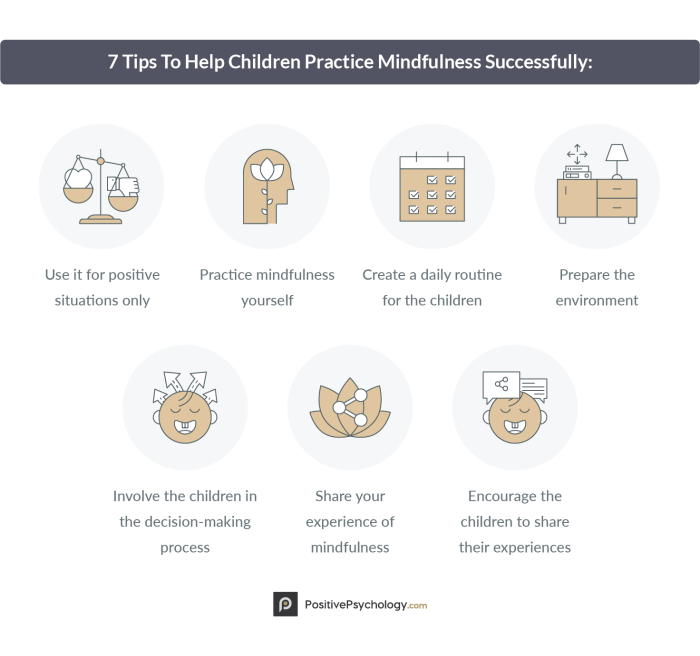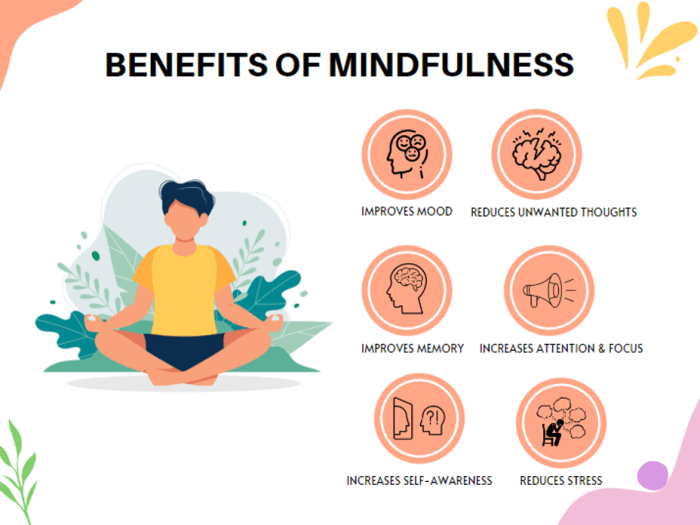3 Mindfulness Exercises for Everyday Practice sets the stage for a journey into the world of mindfulness. Discover the transformative power of these exercises as we delve into a realm of self-awareness and inner peace.
Explore the essence of mindfulness through practical exercises that nourish the mind, body, and soul.
Introduction to Mindfulness Exercises

Mindfulness exercises are practices that focus on bringing one’s attention to the present moment without judgment. These exercises often involve techniques such as deep breathing, meditation, and body scans to help individuals become more aware of their thoughts, feelings, and sensations.Incorporating mindfulness into daily routines is essential as it allows individuals to cultivate a sense of awareness and presence in their lives.
By practicing mindfulness regularly, one can develop a greater capacity to manage stress, improve concentration, and enhance overall well-being.The benefits of practicing mindfulness exercises regularly are vast. Not only can it help reduce anxiety, depression, and negative emotions, but it can also increase feelings of gratitude, compassion, and resilience. Additionally, mindfulness has been shown to improve cognitive function, sleep quality, and immune function.Mindfulness can positively impact mental and physical well-being by promoting relaxation, reducing the effects of stress on the body, and fostering a sense of inner peace.
It can also help individuals become more attuned to their emotions and physical sensations, leading to a greater sense of self-awareness and overall contentment.
Mindfulness Exercise #1: Mindful Breathing: 3 Mindfulness Exercises For Everyday Practice

Mindful breathing is a fundamental mindfulness practice that involves focusing on the breath to anchor yourself in the present moment and cultivate awareness.
Technique of Mindful Breathing
- Find a comfortable seated position with your back straight and your hands resting on your lap.
- Close your eyes and bring your attention to your breath, either at the nostrils, chest, or abdomen.
- Observe the natural flow of your breath without trying to control it. Notice the inhalation and exhalation.
- When your mind wanders, gently bring your focus back to the breath without judgment.
Benefits of Focusing on Breath Awareness
- Reduces stress and anxiety by calming the mind and body.
- Improves concentration and cognitive function by enhancing mindfulness.
- Promotes emotional regulation and self-awareness.
- Enhances overall well-being and promotes relaxation.
Tips to Incorporate Mindful Breathing into Everyday Activities
- Start your day with a few minutes of mindful breathing before getting out of bed.
- Practice mindful breathing during daily activities like walking, eating, or waiting in line.
- Set reminders on your phone or computer to take mindful breathing breaks throughout the day.
- Use mindful breathing as a tool to manage stressful situations or difficult emotions.
Mindfulness Exercise #2: Body Scan Meditation

Body scan meditation involves focusing on different parts of the body sequentially, paying attention to physical sensations, tension, and relaxation. This practice aims to increase body awareness, promote relaxation, and reduce stress.
Process of Conducting Body Scan Meditation
- Find a quiet and comfortable place to lie down or sit.
- Start by bringing your attention to your breath, taking a few deep breaths to center yourself.
- Begin the body scan by focusing on one body part at a time, moving from head to toe or vice versa.
- Notice any sensations, tension, or discomfort in each body part without judgment.
- Take deep breaths and consciously relax each body part as you scan through it.
- Continue the scan until you have covered your entire body.
Benefits of Body Scan Meditation
- Enhances body awareness and mindfulness.
- Promotes relaxation and stress relief by releasing tension in the body.
- Helps in identifying areas of physical discomfort or stress for targeted relaxation.
- Improves overall well-being and mental clarity.
Variations of Body Scan Meditation Techniques
- Guided Body Scan: Listening to a meditation guide leading you through the body scan process.
- Self-Guided Body Scan: Conducting the body scan on your own without external guidance.
- Quick Body Scan: Condensing the practice to focus on key body areas for a shorter duration.
- Progressive Muscle Relaxation: Combining body scan with tensing and relaxing muscle groups for deeper relaxation.
Mindfulness Exercise #3: Mindful Walking

Mindful walking is a form of meditation that involves bringing full attention to the experience of walking, focusing on each step and the sensations that arise in the body. This practice helps cultivate awareness, presence, and a sense of grounding in the present moment.
How to Practice Mindful Walking
- Start by finding a quiet and safe place to walk, preferably in nature or a peaceful environment.
- Stand still for a moment and take a few deep breaths to center yourself.
- Begin walking at a slow and steady pace, paying attention to the movement of your feet and legs.
- Notice the sensations of each step – the lifting of the foot, the shifting of weight, and the contact with the ground.
- Stay present and focused on the physical experience of walking, letting go of any distractions or thoughts that arise.
- If your mind starts to wander, gently bring your attention back to the sensations in your body.
- Continue walking mindfully for a few minutes or as long as you feel comfortable.
Benefits of Mindful Walking, 3 Mindfulness Exercises for Everyday Practice
- Enhances mind-body connection and physical awareness.
- Reduces stress, anxiety, and negative thought patterns.
- Improves focus, concentration, and mental clarity.
- Promotes a sense of calm, relaxation, and overall well-being.
Where and When to Engage in Mindful Walking
- Choose a quiet park, beach, or forest for a peaceful walking experience in nature.
- Practice mindful walking during your daily commute, lunch break, or before bedtime.
- Integrate mindful walking into your routine by making it a regular practice, even for short periods of time.
- Experiment with different locations and times to find what works best for you and fits into your schedule.
Concluding Remarks

Immerse yourself in the practice of mindfulness with these simple yet profound exercises. Embrace tranquility and mindfulness in your daily life for enhanced well-being and inner harmony.